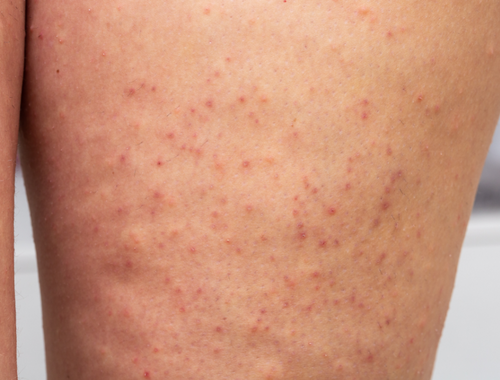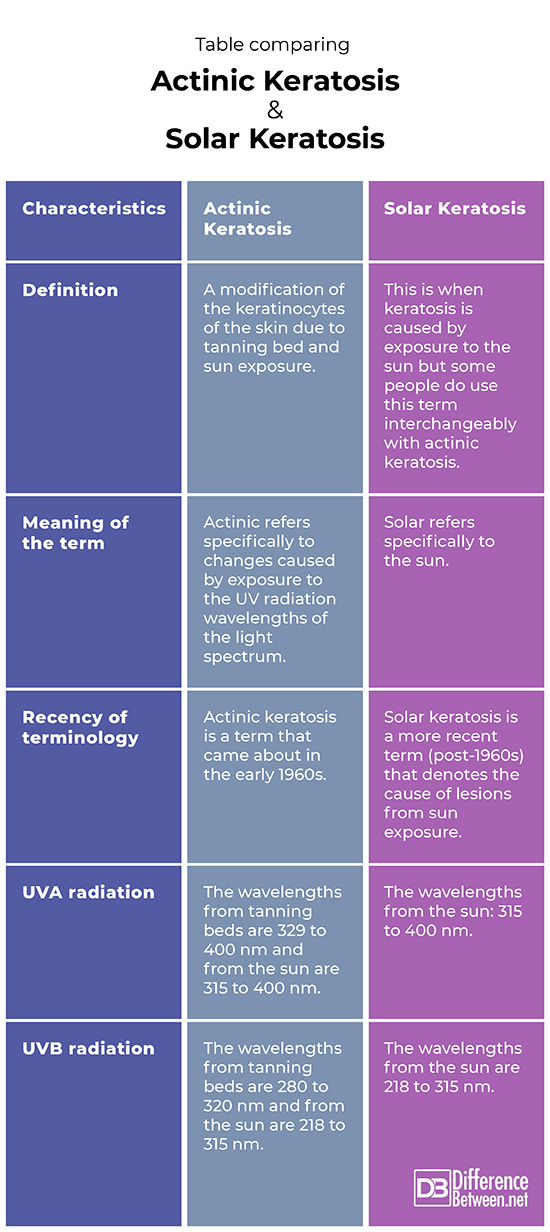Difference Between Actinic Keratosis and Solar Keratosis
Actinic keratosis is when keratinocytes are altered due to exposure to UV radiation from the sun or tanning beds. Solar keratosis is when keratinocytes are modified because of sun exposure.

What is Actinic Keratosis?
Definition:
Actinic keratosis is when lesions develop on the skin because a person has been exposed to excessive UV radiation.
Meaning of the term actinic:
Actinic refers to changes that result from exposure to the UV radiation part of the light spectrum.
Symptoms and complications:
The signs of actinic keratosis are the development of patches of skin that are rough and scaly in texture. The condition can further develop into skin cancer.
Treatment:
Patients need to stop using tanning beds and spending a lot of time in the sun without sunscreen, Certain creams and cryotherapy methods can work to fix the problem.

What is Solar Keratosis?
Definition:
Solar keratosis is the condition in which lesions develop due to long-term sun exposure. This term is often used interchangeably with actinic keratosis.
Meaning of the term solar:
Solar refers to the sun, and solar radiation can cause a lot of skin damage over time. More specifically, solar keratosis refers to changes to the skin cells called the keratinocytes, due to sun exposure.
Symptoms and complications:
Rough and scaly lesions develop on the skin due to sun exposure over time. This is because the UV radiation from the sun damages keratinocytes. The keratosis can become cancerous after a while.
Treatment:
Skin creams and cryotherapy can be used to treat solar keratosis lesions. People should also avoid going into the sun too much.
Difference between Actinic keratosis and Solar keratosis
Definition
Actinic keratosis is a modification of the keratinocytes of the skin due to tanning bed and sun exposure. Solar keratosis is skin changes due to exposure to the sun but some people do use this term interchangeably with actinic keratosis.
Meaning of the term
Actinic means change due to exposure to UV radiation. Solar means relating to the sun.
Recency of terminology
The term actinic keratosis was coined in the 1960s. The term solar keratosis is a more recent term that is used to refer to changes in the skin due to sun exposure.
UVA radiation
UVA radiation involved in actinic keratosis from tanning beds ranges in wavelength from 329 to 400 nm and from the sun is 315 to 400 nm. Using the strict definition of solar keratosis and considering only radiation from the sun, the UVA wavelengths are 315 to 400 nm.
UVB radiation
Actinic keratosis is caused by the wavelengths of UVB radiation from tanning beds, which are 280 to 320 nm and from the sun are 218 to 315 nm. With solar keratosis, the wavelengths of UVB radiation from the sun are 218 to 315 nm.
Table comparing Actinic keratosis and Solar keratosis

Summary of Actinic keratosis Vs. Solar keratosis
- Actinic keratosis and solar keratosis are both terms that are sometimes used to indicate the same condition.
- Actinic refers to the UV radiation changes that cause keratosis.
- While solar keratosis refers to the same condition as actinic keratosis; we can consider this to be specifically referring to sun exposure rather than tanning bed exposure.
FAQ
Is solar keratosis the same as actinic keratosis?
Most medical professionals use the term solar keratosis interchangeably with actinic keratosis because it is the same condition in both cases. However, “solar” refers more specifically to the sun while actinic refers to changes from UV radiation.
Can you pick off actinic keratosis?
It is not a good idea to pick any of the actinic keratosis off because it will only come back and you risk infecting the area by touching and peeling the skin off.
Is actinic keratosis raised or flat?
Most of the time actinic keratosis is present as flat lesions but small raised bumps do occasionally develop on the limbs.
How can you tell the difference between actinic keratosis and seborrheic keratosis?
Unlike actinic keratosis, the lesions of seborrheic keratosis have well-defined edges. Actinic keratosis lesions also are scaly in appearance while lesions of seborrheic keratosis appear waxy.
Should you moisturize actinic keratosis?
Since the lesions are scaly and rough, a moisturizer can be used to help soften these areas of the skin.
What does a solar keratosis look like?
Skin lesions appear as rough or scaly areas of skin that are pink to tan in color.
What is the fastest way to get rid of actinic keratosis?
Cryotherapy in which lesions are frozen off is the fastest way to get rid of the keratosis. Cryotherapy has to be done at a dermatologist’s office. Certain creams may work but take longer to act.
What is the best way to treat actinic keratosis at home?
At home, you can apply Diclofenac sodium gels and creams containing 5-fluorouracil (5-FU).
Is actinic keratosis itchy?
There are times when actinic keratosis lesions may feel itchy.
- Difference Between Rumination and Regurgitation - June 13, 2024
- Difference Between Pyelectasis and Hydronephrosis - June 4, 2024
- Difference Between Cellulitis and Erysipelas - June 1, 2024
Search DifferenceBetween.net :
Leave a Response
References :
[0]Bakshi, A., et al. "The clinical course of actinic keratosis correlates with underlying molecular mechanisms." British Journal of Dermatology 182.4 (2020): 995-1002.
[1]Benedetti, Julia. “Overview of effects of sunlight”. Merckmanuals. Merck & Co., 2019,https://www.msdmanuals.com/professional/dermatologic-disorders/reactions-to-sunlight/overview-of-effects-of-sunlight
[2]Heaphy, Michael R., and A. Bernard Ackerman. "The nature of solar keratosis: a critical review in historical perspective." Journal of the American Academy of Dermatology 43.1 (2000): 138-150.
